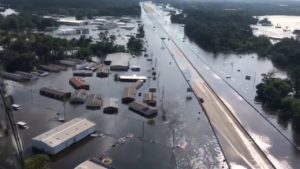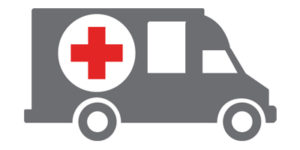 What is the most effective way to deliver resources to a community in need, especially following a natural disaster like Hurricane Harvey?
What is the most effective way to deliver resources to a community in need, especially following a natural disaster like Hurricane Harvey?
We’re still far from knowing the best way, and we won’t all agree on the answer. Should relief come from the federal government, primarily through FEMA and the SBA? Should financial relief come from giant international organizations like the Red Cross, even though the Red Cross has come in for attacks in recent years, for its large overhead costs and uneven on-the-ground effectiveness?
Or should we largely look to private citizens to organize themselves to solve local needs using local resources?
One of the challenges of improving disaster relief is that people won’t go on the record criticizing relief organizations. Well, stay tuned.
Rose City, TX, a 500-person bedroom community next to Beaumont, TX and less than a hour from the Louisiana border, got slammed by Hurricane Harvey. Of the estimated 210 houses in town, Mayor Bonnie Stephenson told me, only two houses escaped flooding.
The financial needs of this town are immense, in part because of the preponderance of retired and low-income households. Another factor in Rose City, according to Stephenson’s estimation, is that after Hurricane Ike flooded the town in 2008, 90 percent of residents could not afford, or declined to get, flood insurance. Without insurance, Stephenson claims, FEMA has declined to help the residents of Rose City rebuild. The Mayor herself had flood insurance, which she’s been unable to collect from FEMA, because of what she calls “red tape.”
For Stephenson, the answer to my question above – the best way to deliver resources – is neither FEMA nor the Red Cross.
“FEMA is not helping,”
she told me.
And the Red Cross?
“Red Cross came in and gave $400 gift cards, but everybody didn’t qualify for this. Some of them were turned down. But why were they turned down? And my question with FEMA,” Stephenson continued, “Why do we have to jump through hoops? Why are we having to wait? We’re not trying to cheat anybody.” And for the rest of the town – the majority of people who didn’t have flood insurance – she asks “Why aren’t they [FEMA] going to help the people who need it the most?”
In response to my questions about who actually has been helping, Stephenson named smaller, self-organizing groups of citizens who came to Rose City’s rescue. Volunteers from the Los Angeles Police Department flew in, the week following the Harvey rains, rented cars in Houston and brought barbecue and generators and lights from Home Depot. Church groups, including Baptists and Mormons and other denominations, she said, came to town. She recalled the self-appointed “Cajun Navy” and later the “Cajun Army” arriving from Louisiana, ordinary citizens delivering hot meals and supplies using their own resources.
 Perhaps the most impressive of all, according to Stephenson, was the one-man operation of Eric Klein, and his no-overhead-cost CAN-DO.org: “I don’t know how we would have done it without him. He knew how to get things organized.”
Perhaps the most impressive of all, according to Stephenson, was the one-man operation of Eric Klein, and his no-overhead-cost CAN-DO.org: “I don’t know how we would have done it without him. He knew how to get things organized.”
I spoke to Klein on the phone recently. He has no doubt in his mind about the answer to my question above.
And politeness about criticizing others’ efforts? That’s not holding Eric Klein back. In fact, he says he got involved in disaster relief 15 years ago precisely because he is fueled by rage – rage at money that never gets delivered. “I have never seen anything this corrupt in my life. People are in dire need, cut off and denied.”
I mention FEMA and the Red Cross. “Red tape is by design,” Klein claims. “Without any doubt [FEMA and Red Cross] create this red tape, and this all happens.”
Shortly after arriving in Rose City in mid-September, Klein recorded a video on Facebook that went viral – 500,000+ views and 16,000+ shares, about a woman sleeping in a tent holding on to the ashes of her deceased son.
In a Not-Suitable-For-Work stream of consciousness video he channels the helplessness and rage of people who have not seen the financial resources of FEMA and the Red Cross show up in Rose City.
In response to what he sees as the financial opacity of big aid organizations, Klein’s calling card is “100% transparency.” He has taken to posting CAN-DO.org’s bank statement on line. He’s self-funded, so all money raised is pledged to Rose City’s residents.
Now, if you ask me, a rational finance guy, whether the one-man-savior approach to disaster relief is the right way, I would say: No way.
In my conversation with Klein, I challenged his approach. Isn’t it inefficient, I argued, to have no infrastructure? How can one dude on his own “scale up” to meet the challenges of a big disaster like Harvey, even in a tiny town like Rose City, Texas?
Klein disagreed, arguing that he’s more than just one man with zero budget, relying on his wits.
“I have the best volunteers. These are top notch. You don’t need to have back office. We designed it this way from day one. We’re going to be as accountable as we can.” He went on: “We’ve been vetted by the top people. We roll into a town, me and a couple of my buddies, and by the end of the week we will have 100 strong.”
In the face of my skepticism about the effectiveness of a one-man relief operation, Klein pulled off a neat trick December 6th, appearing on Megyn Kelly’s Today Show with Rose City’s Mayor, Bonnie Stephenson, gathering a giant-sized $10,000 check from Lowe’s on live TV for their trouble.
What is Klein’s ultimate goal? His medium-size ambition is to convince a corporation like Lowe’s or Home Depot to look at the amount he raises, and match it, after which he plans to distribute loaded gift cards to all of the residents of Rose City, for home reconstruction.
His Texas-sized ambition would be to use his publicity campaign to attract a big donor for something like $1 million. “With $1 million, we could rebuild Rose City!” enthuses Klein.
Please see related post:
Use Caution With The Red Cross
GiveDirectly and Hurricane Harvey (upcoming post)
Post read (131) times.
